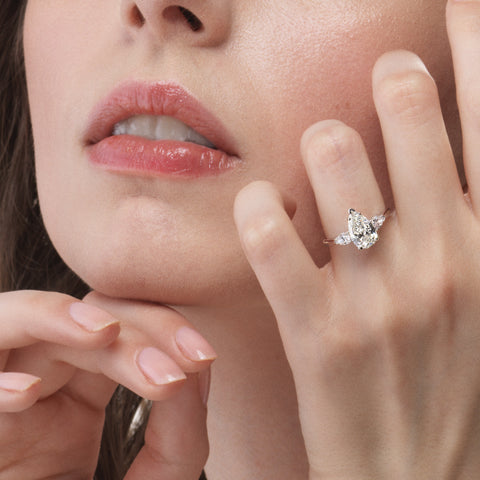Definitive Guide to Clarity Enhanced Diamonds (2023)
by C Mayer • 5 min read
THE BASICS--
Clarity-enhanced diamonds can be affordable options for all sorts of diamond jewelry, from engagement rings and earrings to pendants and bracelets. But what is diamond clarity, and what does it mean when a diamond is clarity-enhanced? This complete guide can be your definitive resource for clarity-enhanced diamonds and whether or not one is right for you.
WHAT YOU NEED TO KNOW--
What are Clarity Enhanced Diamonds?
Many diamonds have subtle enhancements to refine and bolster clarity. Heat or pressure treatments, fills, or coatings can repair certain types of flaws, making them less noticeable and improving overall clarity. The two most common and widely practiced diamond clarity enhancements are:
• Laser Drilling
This technique is often used to access dark spots, mineral deposits, or large inclusions deep within a diamond. A fine laser beam is carefully drilled through the stone into the flaw. Through that microscopic tunnel, a strong mixture of hydrofluoric and sulphuric acids is poured into the stone, which will bleach away darkness and dissolve other materials, removing the chemical inclusion causing discoloration. The acid is then drained out, leaving a lighter, brighter stone with less evidence of any imperfection. This does not repair damage to the stone’s crystal structure, but does make it far less visible.

• Fracture Filling
This technique is used on surface blemishes or deeper fractures that extend to the surface of a diamond. While surface flaws can be cut or polished away by a skilled lapidary, doing so would remove carat weight, while simply filling the fractures is a less time-consuming process that preserves overall carat weight. In this method, molten glass or a glass-like resin is gently pumped into the crack, nick, or fracture, and after hardening, has “filled” the gap and greatly diminished its appearance. Afterward, the stone may be slightly repolished to ensure a clean edge.
These treatments should always be noted in a diamond’s grading report. The type of enhancement can affect how the stone should be handled, such as which cleaning methods are safest and will not destroy the enhancement or aggravate the flaws. If diamond jewelry needs repair or will be reset in the future, knowing about specific clarity enhancements can be helpful to be sure the stone is protected as it is worked on.
Because clarity-enhanced diamonds are not naturally flawless, they are often less valued than untreated stones with minor flaws. This makes clarity-enhanced diamonds more affordable and can be a good trait to consider if a jewelry budget needs some flexibility. It is important to note, however, that clarity- enhanced stones generally have less resale interest than untreated diamonds, particularly since, over time, the enhancements may fade and the diamond’s flaws can become more visible.

Diamond Clarity
Clarity is the assessment of the perfection of a diamond’s crystalline structure. Flaws inside or on the surface of a diamond detract from perfect clarity, but it is important to note that very, very few diamonds are naturally flawless. Flaws range from internal inclusions and different minerals present in the diamond to fractures, chips, and scratches on the surface of the facets.
Many flaws that would seem to detract from perfect diamond clarity cannot be seen with the naked eye. These stones are often labeled as “eye clean” to denote their visual clarity, which may not be the same as a jeweler’s clarity grade. For many people, subtle flaws – while they detract from perfection –add distinction to the diamond, making it recognizable and unique. It is important to note that clarity is not a measure of the fire or sparkle a diamond will show, though this is a common misconception. Clarity only indicates the degree of perfection, while fire, brilliance, and sparkle are related to the gem’s cut and how light interacts with different facets through reflection and refraction.

Disguising Diamond Clarity
There are several clever ways to disguise lower diamond clarity without radical enhancements. A skilled lapidary can easily cut around many types of flaws, either removing the flaw with unused stone or positioning imperfections so they are much less visible. This can be an excellent option for vintage and antique diamond jewelry that may have much more surface wear.
Brilliant-cut diamonds with a greater number of facets reflect and refract more light for better sparkle and fire and help disguise lower clarity. Round, pear, oval, marquise, and heart shapes are often cut for maximum brilliance and are a good choice for lower clarity diamonds. Step cuts such as the emerald or Asscher, however, have broader facets that draw the eye into the stone and make it much easier to see flaws.
Smaller carat weight stones also tend to show flaws less, simply because the stones are proportionally smaller and light reflected within the diamond will better hide imperfections. Clustering several small stones in an illusion or halo setting can disguise lower clarity quite effectively. Open settings such as prong or tension settings allow more light into the stone for better brilliance, but also allow some flaws to be more easily seen. Closed settings like bezels and channels can better conceal flaws, particularly on the edges of diamonds.

Is a Clarity Enhanced Diamond Right For Me?
When shopping for a loose diamond or diamond jewelry, understanding clarity and clarity enhancements can help you choose a better quality stone. Study the stone carefully, particularly from the side to see what flaws may be visible – bearing in mind that few people will examine jewelry so closely while it is worn – and read the gemologist’s report on diamond clarity to be sure you understand any enhancements that have been made. When you understand diamond clarity and what clarity-enhanced diamonds are, you can clearly decide which diamond grades are best for your most beautiful and valuable jewelry pieces.
About Charles Mayer



